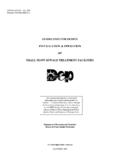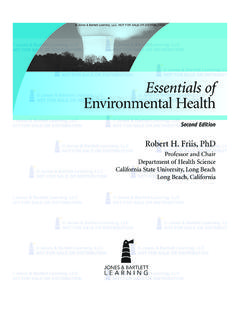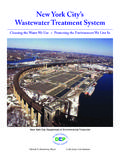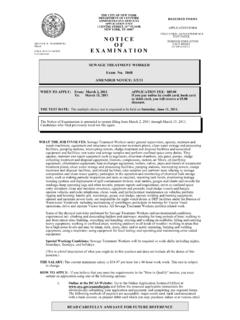Transcription of DUMMY’S GUIDE TO SEWAGE TREATMENT SYSTEMS
1 DUMMY'S GUIDE TO SEWAGE TREATMENT SYSTEMS . GUIDE to SEWAGE TREATMENT Building regulations require foul drainage to be connected to a public sewer or where this is not practicable to one of the following;. 1. Cesspool 2. Septic Tank 3. Package SEWAGE TREATMENT Plant The above options all have advantages and disadvantages, in order to decide which option is most appropriate to meet your requirements please study the following information. CESSPOOLS. What is a cesspool? A cesspool is a SEWAGE holding tank with no outlet. How does it work? SEWAGE flows in and is stored, when the tank is full the waste is tankered away. Site Suitability -Sites where the ground is unsuitable for the waste to soakaway to ground -Sensitive sites SSSI's and sites close to drinking water supplies Advantages Disadvantages + Low installation & maintenance cost -No TREATMENT of SEWAGE -Require regular emptying SEPTIC TANKS.
2 What is a septic tank? Multi-chambered tank with an outlet. How does it work? Primary tanks facilitate primary TREATMENT to take place (the separation of liquids and solids by gravity). SEWAGE flows into the tank and the heavy solids sludge' sink to the bottom, lighter solids, grease and oils or scum' float to the surface. Some of the sludge is degraded by naturally occurring anaerobic (without oxygen) bacteria. The liquid effluent flows via gravity out of the tank and discharges to land by soakaway. Please note that some older septic tanks still discharge directly to watercourses. However this practice is becoming less common due to more stringent consent standards. See below regarding Consent to Discharge. Site Suitability - Single domestic house or small developments - Where there is sufficient porosity in the ground to allow for soakaway (ground porosity determined via percolation tests, for information on how to carry out percolation tests please contact us).
3 Advantages Disadvantages + Relatively low installation cost -Require emptying on an annual basis + Some TREATMENT -Can only discharge where ground has White Wall Nook Vineyard Business Centre Wark Saughland Hexham Midlothian Northumberland EH37 5XP. NE48 3PX Tel: 01875 321151. Tel: 01434 220508. sufficient porosity PACKAGE SEWAGE TREATMENT PLANT. What is a TREATMENT plant? A TREATMENT plant is a more sophisticated unit than a septic tank, there are different types of package SEWAGE TREATMENT plant but they all generally follow the same principles. How does a TREATMENT plant work? Package SEWAGE TREATMENT plants create an environment which facilitates the growth of bacteria which break down SEWAGE into non- polluting end products. TREATMENT plants differ from septic tanks as not only does primary TREATMENT take place but also secondary TREATMENT .
4 This requires an electricity supply which is used to artificially introduce air to the TREATMENT plant; it is this oxygen transfer through the SEWAGE which enables the growth of aerobic bacteria which are more effective in the breakdown of SEWAGE than the bacteria present in a septic tank. This results in a higher quality effluent being produced, which can (subject to Environment Agency Consent to Discharge) be discharged directly to a watercourse. Site Suitability -Package SEWAGE TREATMENT plants are suitable for most sites from single domestic house up to 1000pe. - Subject to Environment Agency or SEPA, whether they will grant you consent to discharge to land or to watercourse Advantages Disadvantages + SEWAGE treated to higher standard -Require electricity supply + Suitable for larger developments - Require regular maintenance to ensure efficient operation CONSENT TO DISCHARGE.
5 What is a Consent to Discharge? It is in effect a licence which allows you to discharge treated SEWAGE subject to consent limits to either ground or surface water. Do I need to apply for a Consent to Discharge'? If you intend to discharge anything other than clean, uncontaminated surface water to surface waters or groundwater you need to obtain a discharge consent from your Environmental Regulator failure to do so may result in enforcement action by your Environmental Regulator. How do I apply? To apply for a consent to discharge it is advisable to contact your local Environment Agency or SEPA. office, they will then give you an indication as to what level of TREATMENT is required this will help you form the decision as to what TREATMENT system is suitable for your site. You will then have to complete a Consent to Discharge Application Form' and pay an application fee, the amount of fee is dependant upon the amount of SEWAGE you propose to discharge.
6 Please note completion of an application form and payment of fee does constitute permission to discharge. What is a consent limit? The Environment Agency and SEPA specify that a discharge has to meet certain discharge standards or consent limits. These are either descriptive' or numeric'. A descriptive consent limit means that as long as the effluent looks clear and doesn't appear to have a detrimental effect on the environment then it is clear enough to discharge. A numeric consent limit is where the EA or SEPA will specify figures in milligrams per litres for the following parameters Biochemical Oxygen Demand (BOD), Suspended Solids (SS) and Ammonia (NH3) permitted in the discharge effluent. White Wall Nook Vineyard Business Centre Wark Saughland Hexham Midlothian Northumberland EH37 5XP. NE48 3PX Tel: 01875 321151. Tel: 01434 220508.
7 INSTALLATION. Who do we have to talk to? All installation procedures should be carried out observing the requirements of the relevant legislation. The two bodies who must be contacted are the local authority building control and the environment agency (as previously mentioned). These regulatory institutions will give guidance as to where a TREATMENT plant and discharge point or soakaway can be situated. Do we need planning Permission? At the discretion of the local authority, in some areas of the country a TREATMENT plant may need planning permission. If the plant is being installed as part of a new build project then permission should be part of the main approval. However it should be noted that on many planning approval documents a phrase which is quite common in the conditions is subsequent to EA/SEPA approval'. This means that a response is required from the EA before your project has full planning permission.
8 Who should install the system ? The installation should be carried out by suitably trained and qualified personnel. Normal safety precautions must be taken and appropriate procedures observed to avoid accidents. Specialist advice is required when installing in an area with adverse ground conditions rock, running sand, high water table. Installation close to trees and shrubs is not recommended. For more information regarding installation procedures please contact us. White Wall Nook Vineyard Business Centre Wark Saughland Hexham Midlothian Northumberland EH37 5XP. NE48 3PX Tel: 01875 321151. Tel: 01434 220508.







